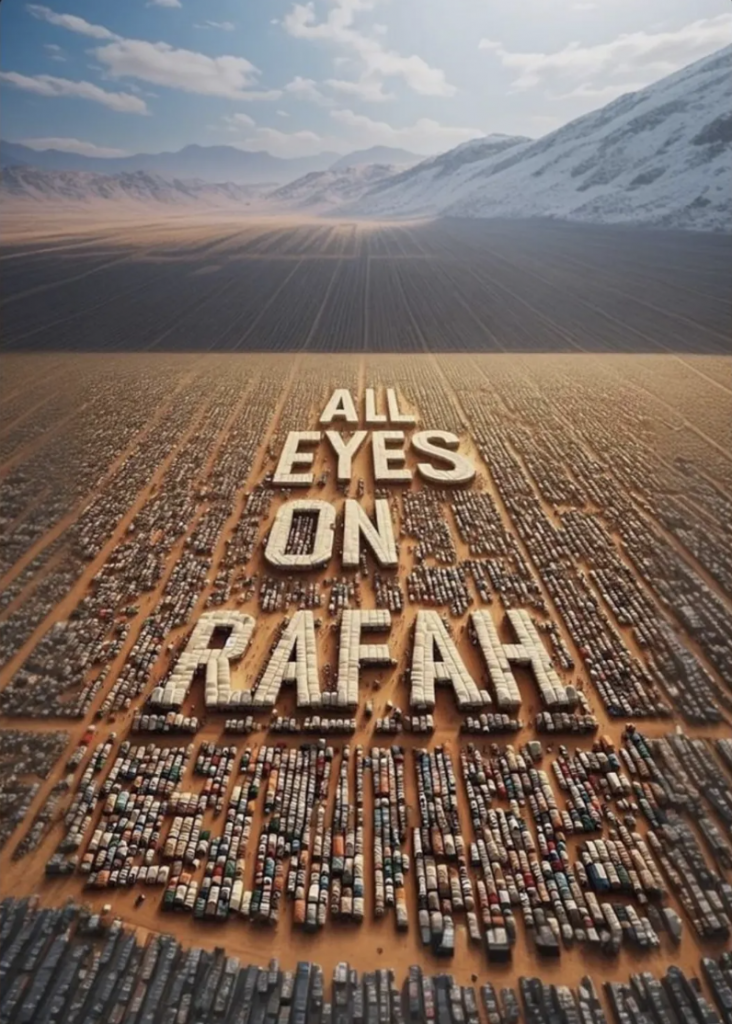During the last week of May, a trend emerged on social media and instantly became a phenomenon. An AI-generated image saying “All Eyes on Rafah” surpassed almost 50 million shares on Instagram through its “Add Yours” feature. This phenomenon stirred commotion in the digital socio-political atmosphere as the world witnessed a rising tide of activism expressed through art.
Ever since that day a variety of outrageous opinions, rightfully so, have surfaced calling out the “cleanliness” and “sanitized” image with elegantly arranged rows of tents for drastically displaced Palestinians in Rafah when there were actually graphic images of beheaded children and people burnt alive in their sleep.

Amidst this situation, one is compelled to interrogate the very reason behind the angst and yet being unable to escape the only means of showing solidarity, indeed this is another addition to the dilemmas of modern humans.
The exposure to any form of war art forces the man to see beyond his everyday struggles by acquainting himself with the horrors of losing lives of their loved ones to a cause largely unknown to them. It is not the first time that a war or genocide or terrorism has led to the birth of a visual expression intending to disturb something deep within its subjects. Borrowing the beautiful words of James Baldwin,
“The role of the artist is exactly the same as the role of the lover. If I love you, I have to make you conscious of the things you don’t see.”
Although modern art has always been a flag-bearer of naked truth exposing the atrocities committed during wars and genocides. But there has been a significant deviation observed in the trend since the inception and intrusion of AI-generated art. This intervention of AI combined with the “aesthetic” preconditions of social media platforms has resulted in the emergence of an ‘impotent’ art which is not only deficient in capturing the essence of suffering but also are, quite unfortunately, adamantly demeaning towards the lived experiences of Palestinians.
In this case, the virality of an AI-generated image to be shared by such a huge number of individuals across the globe is concerning as it seems to promise an eternal slumber to the larger conscience of the global community by keeping their eyes off the grim realities in not the ‘war-torn’ but ‘genocide-torn’ region.
It is correct and known that the social media platforms are automated to flag any graphic content meanwhile through the stroke of some unseen luck has managed sustain Pablo Picasso’s excruciating work like “Guerinica” which is also available on the same platforms.
Historically, these works have managed to remain perpetual reminders of the tragedies inflicted upon humanity by none other than their fellow humans who somehow managed to display unfathomable monstrosity.
These paintings have never failed to disturb, disrupt, and discompose the inner conscience of humans. Similarly, “War” by Marc Chagall, “The Mass Grave” and “Massacre in Korea” by Pablo Picasso, “The Prager Street” by Otto Dix and many more. These are works of art that have marked their undefeatable territories in the memories of people who’ve seen them.
Meanwhile, the role of art and artists under the omni-present influence of AI with “aesthetic” as its sole target is emerging as a business success but a failure of humanity. To quote some cases in point, the award-winning AI artist, Sara Shakeel shared some posts on Instagram in Palestinian solidarity with heavenly imagery.
These were charged with the message that although the Palestinians couldn’t live a beautiful life in this world but a magnificent life awaits the dead in the afterworld. The message is comforting and full of religious hopefulness but is it doing justice to the suffering and how the Palestenians are being brutally wiped off?
By putting these images in contrast, it is clearly evident that the AI-generated ‘aesthetic’ has finally managed to bargain the human responsibility possessed by each of us for the number of shares. The soul of protest has unfortunately departed the body of this modern AI-generated art as resistance stands mourning at its grave. This is how the imagination, which is the language of a conscience entrenched in guilt, despair, and desire to expose the inhumane, has been held captive aimed to avoid the ‘censorship’, ‘taking down’ and ‘flagging’ which stands victorious while humanity stands ashamed and questionable. In fact, it is not even a matter of shame but simply of an evolved perspective which has nothing but all so charmingly drugged unconscious using the sedative called “aesthetic”.
Art is meant to narrate the nascent truth and to convey unfiltered reality and only by abstaining from this unnecessary aestheticism, especially AI-generated aestheticism which is hyper-fixated on disrupting the narrative of protest and is acting as a pacifier, compelling the viewers to feel less about the horrendous reality of the genocide.
It is a well established fact that the meaning of art transcends beyond its varied and even conflicting interpretations but it’s impossible to negate the significance of a visual experience and its potential to implant a narrative, deeply political (as there is no apolitical art), in the human subconscious. This aestheticism in the digital age has socio-political implications as it tends to render the lived experiences of not just the Palestinians suffering at the moment but of all the unjustified killings committed till date.
Moreover, these aesthetic images appeal mostly because they effortlessly dodge the bullet of censorship charges by digital platforms which makes it even more problematic as the images themselves are nothing but the embodiment of censorship. The hypocrisy of AI-generated art is also undeniable because it restricts one to generate anything that doesn’t fit a certain criteria implying an implicit commodification purpose.
Commodification of art, labelling it as aesthetic, during a genocide is dehumanization at its peak and as the global community strives to stand in solidarity with Palestine, they must carefully incorporate every minute symbol of resistance in their respective forms of protest.